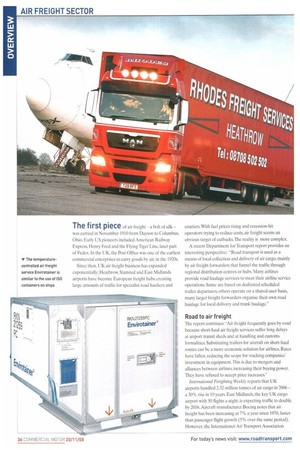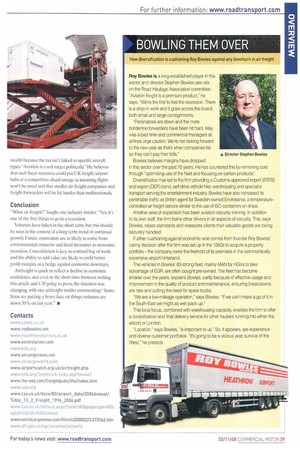AIR FREIGHT SECTOR
Page 34

Page 36

Page 37

Page 38

Page 39

If you've noticed an error in this article please click here to report it so we can fix it.
As the credit crunch bite's and the price of oittontinues to fluctuate,
air trgight is one of the most obvious areas to he.hit. But things are not that predictable in the business, as we found out The first piece of air freight — a bolt of silk— was carried in November 1910 from Dayton to Columbus. Ohio. Early US pioneers included American Railway Express, Henry Ford and the Flying Tiger Line, later part of Fedex. In the UK, the Post Office was one of the earliest commercial enterprises to carry goods by air, in the 1920s.
Since then, UK air freight business has expanded exponentially; Heathrow, Stansted and East Midlands airports have become European freight hubs, creating large amounts of traffic for specialist road hauliers and couriers. With fuel prices rising and recession-hit operators trying to reduce costs, air freight seems an obvious target of cutbacks. The reality is more complex.
A recent Department for Transport report provides an interesting perspective: "Road transport is used as a means of local collection and delivery of air cargo, mainly by air freight forwarders that funnel the traffic through regional distribution centres or hubs. Many airlines provide road haulage services to meet their airline service operations. Some are based on dedicated scheduled trailer departures, others operate on a shared-user basis, many larger freight forwarders organise their own road haulage for local delivery and trunk haulage."
Road to air freight
The report continues: "Air freight frequently goes by road because short-haul air freight services suffer long delays at airport transit sheds and at handling and customs formalities Substituting trailers for aircraft on short-haul routes can be a more economic solution for airlines. Rates have fallen, reducing the scope for trucking companies' investment in equipment. This is due to mergers and alliances between airlines, increasing their buying power. They have refused to accept price increases."
International Freighting Weekly reports that UK airports handled 2.32 million tonnes of air cargo in 2006 — a 30% rise in 10 years. East Midlands, the key UK cargo airport with 50 flights a night, is expecting traffic to double by 2016. Aircraft manufacturer Boeing notes that air freight has been increasing at 7% a year since 1970, faster than passenger flight growth (5% over the same period). However, the International Air Transport Association
(IATA) says international traffic data for May 2008 showed a drop in cargo growth to 1.3%, considerably down from the 4.3% growth recorded in 2007.
"The high price of oil is reshaping the industry," says IATA director general and chief executive Giovanni Bisignani. Some analysts also think the strength of the euro has damaged competitiveness for European exports and the European air cargo business.
Air Cargo World magazine warns: "Weakening freight growth for 2007 presaged a slowdown in 2008 for air cargo, indicating a loss of market share to ocean shipping."
International air cargo traffic fell 1.9% in July 2008. The decline marked the second consecutive monthly drop in global air cargo business and the steepest decline since the terrorist attacks in September 2001.
Rose Bridger, an analyst for environmental group Aircraftwatch,says:"The perishable air freight sector accounts for 14% by volume of total global air freight and is increasing at about 10% a year. Air cargo requiring temperature control, often with a short shelf-life, includes photographic equipment, chemicals and medicines, The majority of perishables, approximately 80% by volume. are food — fresh and pre-prepared chilled — and ornamental plants Asda has announced it will source an additional .00m-worth of fresh produce from Africa."
Mail makes up a considerable percentage of air freight in the UK, often travelling at night.The change in EU hours regulations led to Exeter airport handling more mail than ever: an average of 568kg of post passes through on flights to East Midlands and Stansted airports six nights a week. Recently the Civil Aviation Authority told a government committee: "Air freight would benefit from better road and rail linkages to airports" Heavy load A lot of heavy shipments are air freighted: racing cars; fuel and equipment; an ice rink; a four-tonne statue of Buddha. Construction material is a growth sector for cargo at many airports A snapshot of just one carrier — British Airways World Cargo (BAWC) — shows how air freight is developing. BAWC has increased its European short-haul freight service by 40%, and the number of weekly services from 32 to 45 across 11 European destinations. Additions to long-haul routes include Tbilisi in Georgia, with the eastbound leg filled predominantly with oil and gas equipment and heavy machinery. A new weekly allfreight route with 100 tonnes of capacity starts at Stanstecl and goes to Munich, then Delhi and Hong Kong. British fashion buyers rely twice as much on air freight for imports from China and India as the French and get new weekly services from Karachi and Lahore in Pakistan. Expansion continues at BAWC's Heathrow perishables handling centre for temperature-controlled goods.
The Freight Transport Association (FTA) states: "Air freight is used to transport high-value, small-sized commodities quickly to markets worldwide. Frequently, these are products with a short life span, such as medicines, or those that underpin the UK service economy, such as financial documents. The importance of air freight is shown by the fact that while it represents less than I% of UK trade in products by tonnage, it represents 30% of exports by value."
Tax changes
FTA head of policy Chris Snelling says: "Air freight can't easily be switched to other modes; by its very nature it is urgent, perishable or a distress purchase."
He warns of proposed tax changes to the UK aviation industry in 2009. Rather than the current tax based on the number of passengers carried, a tax may be levied on all take-offs based on overall weight. This will, says the FTA, disproportionately affect long-haul flights and freight (90% of cargo is carried in bellyholds).
Snelling rejects the suggestion of the tax helping to lower emissions. "It's more likely goods will be flown to Paris then trucked in." He sees it as revenue-raising by stealth because the tax isn't linked to specific aircraft types: "Aviation is a soft target politically." He believes that such fiscal measures could put UK freight airport hubs at a competitive disadvantage as incoming flights won't he taxed and that smaller air freight companies and freight forwarders will be hit harder than multinationals.
Conclusion "What air freight?" laughs one industry insider. "Yes, it's one of the first things to go in a recession.
Volumes have fallen in the short term, but this should he seen in the context of a long-term trend of continual growth. Future constraints are as likely to come from environmental concerns and fiscal measures as economic recession. Consolidation is key, so a mixed hag of work and the ability to add value are likely to yield better profit margins as a hedge against economic downturn.
Airfreight is quick to reflect a decline in economic confidence, and even in the short time between writing this article and CM going to press, the situation was changing, with one airfreight insider commenting: "Some firms are putting a brave face on things, volumes are down 30% on last year." •
Contacts www.saints.co,uk www.roybowles.net www.heathrowcouriers,co.uk www.envirotainer.com www.bifa.org www.aircargonews.nek
www.aircargoworld.co re www.airportwatch.org.uk/airfreight.php www.bifa.org/Contentirk-tinks.asp?muldd www.ifw-net.com/freightpubs/ifw/index.htm wwwiata.org www.caa.comk/docs/80/airport_data/2006Annuall Table_13_2_Freight_1996_2006.pdf www.caa.co.ukidefault.aspx?catidr-808,pagetyper.88EL
sit i cl1.34 I 21306A nnua I
www.wor1dcargonews.com/htm/n20050223.573162.htm www.clftgov.uk/pgr/a'nation/airports




























































































































































